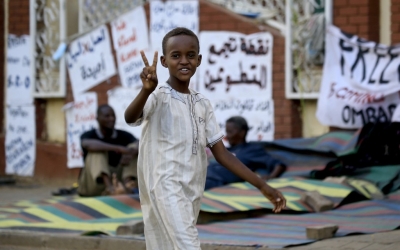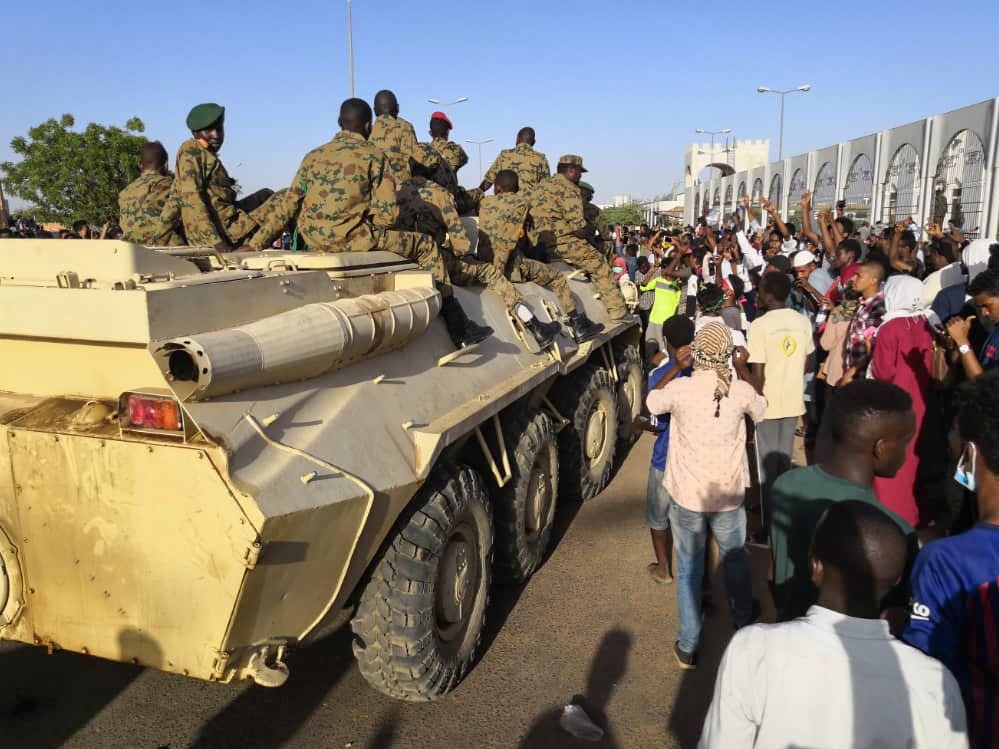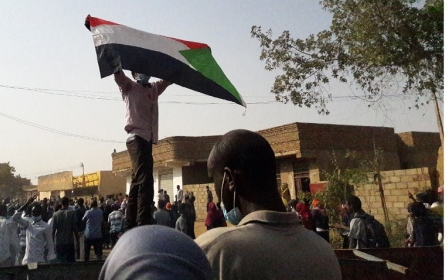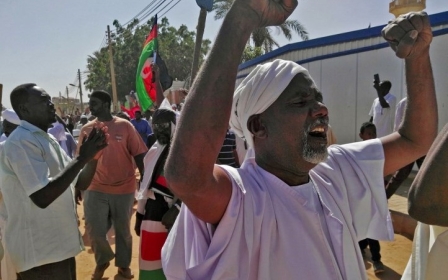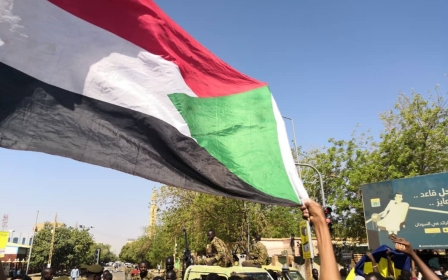Sudan protests: Will the army side with the people against the regime?
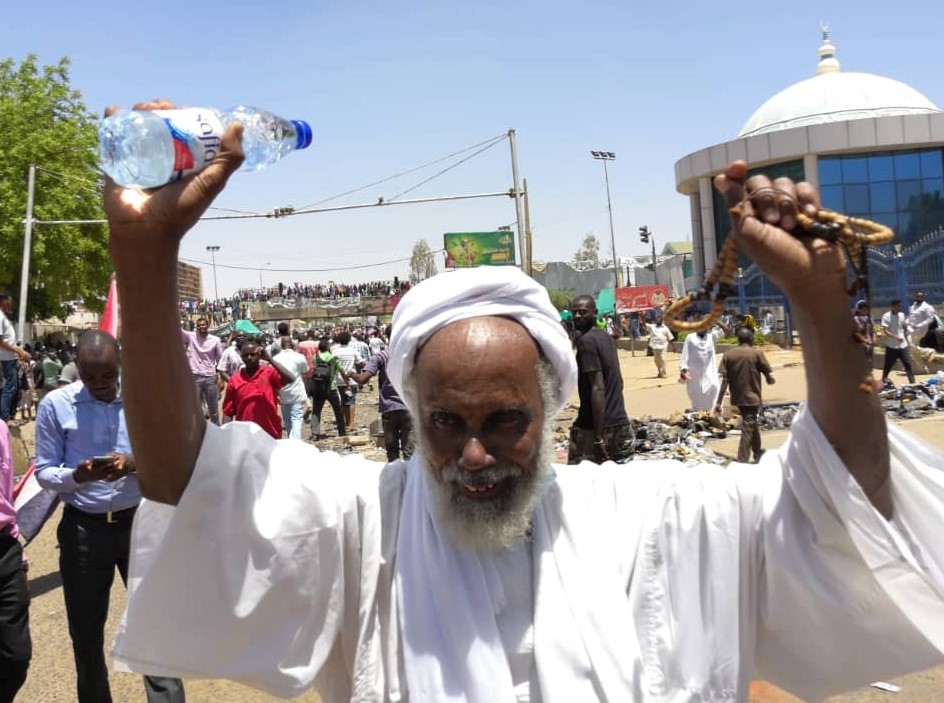
For over two days now, thousands of protestors have been staging a sit-in within the headquarters of Sudan’s armed forces in central Khartoum, demanding that the military intervene in support of the four-month-long popular uprising.
The occupation of the army headquarters coincided with the largest anti-regime rally to date on 6 April, as thousands took to the streets to chant the uprising’s main slogan, "just go" (tasgut bas).
A significant portion
The 6 April marks the symbolic date on which, during the country’s last popular uprising in 1985, the military leadership declared that it would "side with the people". So far, the sit-in appears to have been conducted with the support of a significant portion of the officers as well as the rank and file.
The sit-in appears to have been conducted with the support of a signification portion of the officers as well as the rank on file
Indeed, early on the morning of 8 April soldiers clashed outside the military headquarters with security agents and regime-backed militias who were trying to clear out the protestors, leading to the death of two members of the armed forces.
New MEE newsletter: Jerusalem Dispatch
Sign up to get the latest insights and analysis on Israel-Palestine, alongside Turkey Unpacked and other MEE newsletters
The last two uprisings that overthrew authoritarian regimes in 1964 and 1985 provide important precedents for the soldiers' support of the protesters.
In both cases there was close co-ordination between the professional groups leading the popular mobilisation and the dissidents in the military.
The actions of those professional bodies in many ways prefigure those of today’s Sudan Professional Association, which over the weekend emulated its predecessors in declaring a general strike throughout Sudan and which has been actively calling for the army to support the uprising.
Why are Sudanese protesting against their government?
+ Show - HideSudanese protests have evolved in the space of less than six months from complaints about bread prices to calls for long-term leader Omar al-Bashir to go and demands for a civilian-led transition to democracy.
Here's a summary of the key moments so far since the protests began.
19 December 2018: People take to the streets in the city of Atbara to protest against a government decision to triple the price of bread, torching a local ruling party office. By the next day protesters on the streets of Khartoum and other cities calling for "freedom, peace, justice". Police try to disperse the crowds, resulting in at least eight deaths. Dozens more will be killed in the weeks of protest that follow
22 February 2019: Sudanese President Omar al-Bashir declares a nationwide state of emergency. He swears in a new prime minister two days later, as riot police confront hundreds of protesters calling for him to resign
6 April: Thousands gather outside the army's headquarters in Khartoum, chanting "one army, one people" in a plea for the military's support. They defy attempts by state security forces to dislodge them and troops intervene to protect them
11 April: Military authorities announce they have removed Bashir and that a transitional military council will govern for two years. Despite celebrations at Bashir's demise, protest leaders denounce the move as a "coup" and the protesters remain camped outside army headquarters.
14 April: Protest leaders call on the military council to transfer power to a civilian government
20 April: Sudan's military rulers hold a first round of talks with protest leaders
27 April: The two sides agree to establish a joint civilian-military ruling council, but talks stall over differences in the composition of the council, with both sides demanding a a majority
15 May: With negotiators reported to be close to agreeing a three-year transition to civilian rule, military leaders suspend talks and insist protesters remove barricades outside the army's headquarters. Talks resume on 19 May but break down again on 20 May, with the opposition insistent that a civilian must head the transitional governing body
28 May: Thousands of workers begin a two-day strike to pressure the military rulers and call for civilian government
3 June: At least 35 people killed and hundreds injured, according to opposition-aligned doctors, as security forces firing live ammunition move to disperse the protest camp outside army headquarters
4 June: General Abdel Fattah al-Burhan, the head of the military council, announces that all previous agreements with protest leaders are scrapped and says elections will be held in nine months
Discontented radicals
In 1964, members of the Free Officer Organisation, with strong ties to the leftist and Arab socialist groups of the day, refused commands to fire on protestors. In 1985 an unconnected organisation of the same name played a similar role in ensuring that the army did not target the popular demonstrations.
Both organisations were formed by discontented radicals in the junior ranks, although they had important contacts further up the chain of command.
However, in neither instance did the radical young Free Officers actually lead the transition to democracy.
In 1964, it was the middle and senior echelons that persuaded the president and commander in chief, Ibrahim Abboud, to dissolve his army-led government, whereas in 1985 the commander in chief Abdulrahman Siwar al-Dahab unseated the military president, Jafaar Nimeiri, and established a Transitional Military Council.
A similar pattern
During the 2018-2019 uprising, which has already lasted far longer than either of its predecessors, there has been little sign that the pattern of pressure by the junior ranks causing an intervention by senior officers will repeat itself.
The military commander-in-chief, Kamal Abd al-Maarouf al-Mahi, and the rest of the high command may have failed to prevent their officers supporting the protests at army headquarters but they have certainly not shown any inclination to join them.
The army command’s refusal to challenge the regime may well be due to the ruthless purging and manipulation of the military leadership by Omar al-Bashir, who, after his Islamist backed coup of 1989, replaced most the senior officers with allies dedicated to the ideology of the National Islamic Front.
It is the lower echelons of the military that are confronting the regime’s parallel security force in the streets
However, today the Islamists are divided and have lost much of the hubris that brought about the disastrous "Civilizational Project" of the 1990s.
What is keeping the military leadership on the side of the regime and the security organisations aligned to it is less ideological commitment so much as fear of recrimination for their role in the regime’s multiple war crimes, as well as their interest in preserving a government that continues to allocate the vast majority of its budget to the defence sector.
In 1985, the rivalry between the army and Nimeiri’s State Security Organization (SSO) went as far up as the deputy commander in chief. Within two days of the army leadership’s decision to "side with the people" on 6 April, it was able to swiftly and bloodlessly occupy the SSO headquarters and dismantle the organisation.
It also dissolved the ruling party and prevented Nimeiri from returning to Sudan. The result was a relatively smooth transition to multi-party democracy one year later, although by seizing control of the uprising, the military leadership was also able to suppress a number of its more radical aspirations.
The ultimatum
On 8 April 34 years later, it is the lower echelons of the military that are confronting the regime’s parallel security force in the streets, and it does not appear that the results will necessarily be as decisive or as immediate.
These events follow the ultimatum issued to the army leadership on 6 April by an organisation referring to itself as "The Honourable of the Armed Forces" which declared that if the high command did not align itself with the popular uprising in 24 hours, officers, NCOs and troops would take to the streets in their official military clothing in support of the revolution.
There are precedents for political formations in the military rebelling against the high command. However, these occurred during the coups of 1969 and 1989 when ideological cells within the military - the original Free Officer Organisation, in the first instance – overthrew the very democracies the first two popular uprisings of 1964 and 1985 had brought about.
A different transition of power
If a revolt against the military leadership were to break out now with popular mobilisation at its peak, a very different transition of power might result, and potentially a much more intense conflict with the other security forces.
The uprising of the young army officers reflects the generational cleavages of the uprising as a whole, during which youthful voices have called for a more radical transition from the existing social order.
From the perspective of Sudan’s democrats, the risk is that either the current leadership or a new force within the military may, in the name of "siding with the people", hijack the transition so as to preserve the privileges that have accrued to the army over 30 years of authoritarian rule.
The actions of the Egyptian military subsequent to the Arab Spring serve as a warning here. Hopefully the example set by the last two uprisings in 1964 and 1985 will mitigate against such a possibility.
The views expressed in this article belong to the author and do not necessarily reflect the editorial policy of Middle East Eye.
Middle East Eye delivers independent and unrivalled coverage and analysis of the Middle East, North Africa and beyond. To learn more about republishing this content and the associated fees, please fill out this form. More about MEE can be found here.



